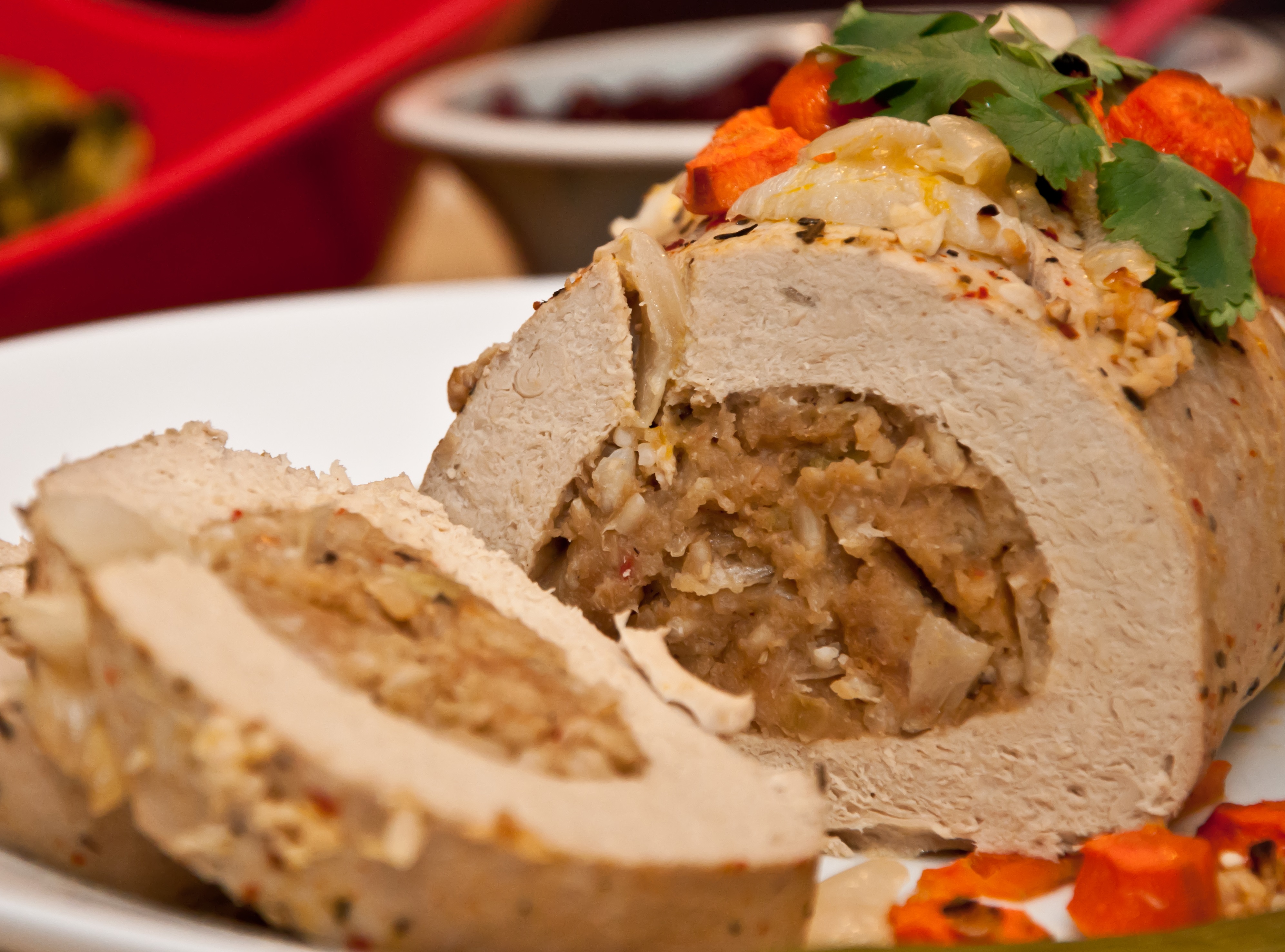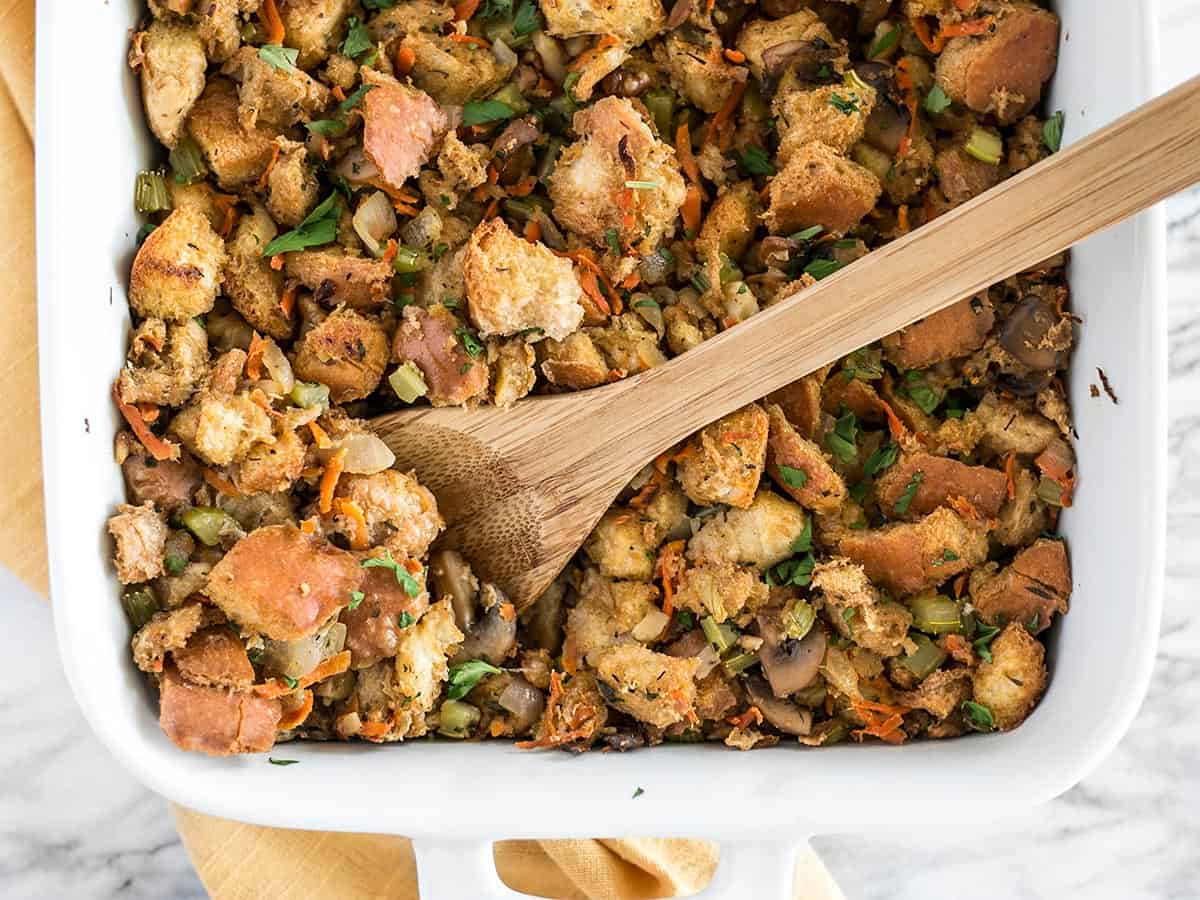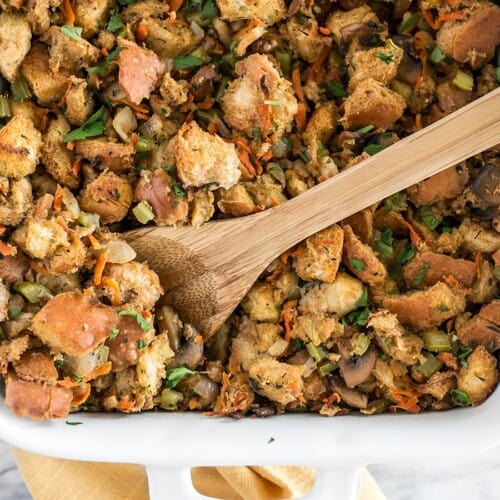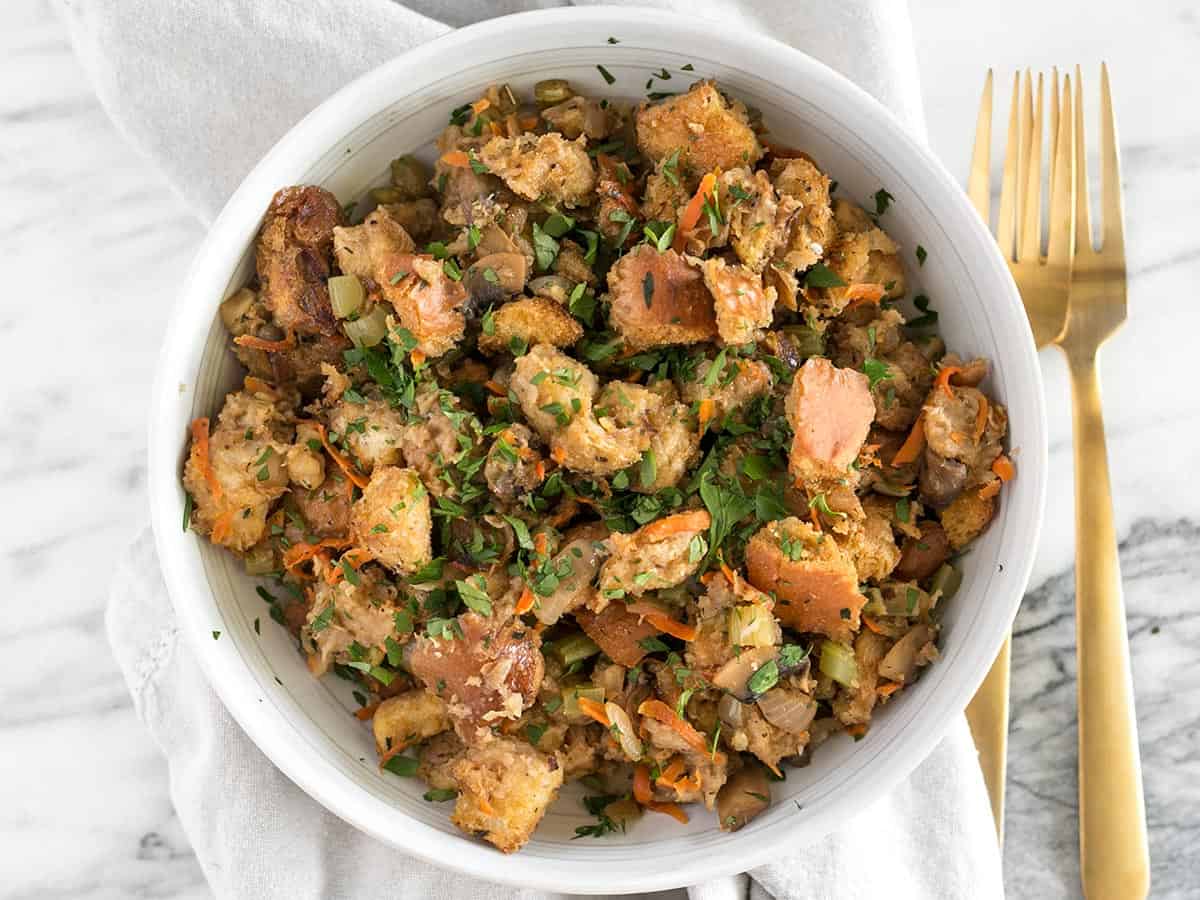Stuffing, or “dressing” if you live in the south, is one of the best parts of Thanksgiving dinner. But usually it’s made with the rich drippings from the roasted turkey, which means it’s off limits for vegetarians. But worry not! We’ve crafted a Vegetarian Stuffing recipe that is every bit as flavorful with its toasty cubes of bread, colorful vegetables, an aromatic blend of herbs, and a rich vegetable broth. This vegetarian stuffing is absolutely to die for and might just become your new staple Thanksgiving dinner recipe!
Stuffing is one of the best parts of a holiday meal. That savory, herbaceous bread filling pairs so perfectly with turkey, mashed potatoes, and cranberry sauce. But many traditional stuffing recipes call for sausage, oysters, or other animal products. If you want to keep your meal vegetarian, or cook for vegetarian guests, you need an equally delicious meatless stuffing.
In this article, I’ll walk you through everything you need to know to make irresistible vegetarian stuffing for your turkey. From ingredient ideas to cooking tips, you’ll be ready to make this Thanksgiving side into the star of the show.
Why Make Vegetarian Stuffing?
There are a few key reasons why vegetarian stuffing is a great choice:
-
Accommodate Dietary Restrictions If you or your guests don’t eat meat, animal products like sausage and chicken stock are off the table. Vegetarian stuffing allows everyone to enjoy this holiday classic.
-
Health Benefits: Vegetarian stuffings skip the saturated fat and cholesterol found in meat-based versions. Loading up on vegetables, herbs, and whole grains instead is much healthier.
-
Explore New Flavors Taking meat out of the equation allows you to get creative with vegetables, nuts, dried fruits, and herbs The possibilities are endless!
-
Save Money: Sausage and seafood can get pricey. Vegetarian stuffing is made with economical ingredients like bread, onions, and celery.
-
Simpler Cooking There’s no meat to cook in advance for vegetarian stuffing. Just sauté some veggies, mix it all together, and bake
With so many benefits, vegetarian stuffing is a great choice for your holiday table. Now let’s talk about how to make it amazing.
Choosing the Right Vegetables
One key to excellent vegetarian stuffing is loading it up with flavorful vegetables. Here are some of my favorites:
-
Onions: An absolute must! Their sweetness balances out the other vegetables.
-
Celery: Provides a slightly bitter, fresh contrast. Leave some leaves on for extra flavor.
-
Carrots: Add a touch of natural sweetness.
-
Mushrooms: Meaty, umami-rich flavor and texture.
-
Apples or Pears: Fruity twist with a subtle sweetness.
-
Butternut Squash: Sweet, creamy base when roasted.
-
Corn: Fresh kernels or frozen are easy additions.
-
Chestnuts: Toasted, they add a richness similar to sausage.
Mix and match from this list based on what’s in season and your flavor preferences. Just be sure to chop or dice the veggies small so they mix in evenly.
Herbs and Spices to Season Vegetarian Stuffing
The right blend of herbs and spices makes stuffing sing. These are must-have flavors:
-
Sage: The quintessential stuffing herb. Use lots!
-
Thyme: Earthy background note.
-
Rosemary: Piney, pairs well with mushrooms.
-
Parsley: Fresh, green flavor.
-
Black Pepper: Key for seasoning.
-
Onion and Garlic Powders: Umami boosters.
-
Cayenne or Red Pepper Flakes: Warming heat (use a light hand).
-
Marjoram, Oregano, Savory: Dried Mediterranean herbs.
-
Poultry Seasoning: Classic flavor (omit the rosemary).
Start with sage as the backbone, then layer on other herbs and spices to create your signature blend.
Picking the Right Bread for Vegetarian Stuffing
Obviously bread is the backbone of any good stuffing. You want a solid base with lots of nooks and crannies for soaking up delicious flavors. Here are some top options:
-
Sourdough: Tangy flavor and chewy texture.
-
Rye or Pumpernickel: Deep, earthy taste.
-
Challah: Light, eggy, and tender.
-
Baguette: Sturdy crumb soaks up liquid.
-
Cornbread: Crumble it on top for crunch.
-
Gluten-Free Bread: Look for sturdy whole grain loaves.
Choose day-old or stale bread and cut it into 1/2 to 1 inch cubes. Larger pieces will stay more intact in the stuffing. Fresh bread can be dried out ahead by leaving it uncovered overnight or baking at 250°F until dried but not browned.
Adding Delicious Extras
Once you’ve got the base of vegetables, herbs, and bread down, feel free to toss in any of these extras to make your vegetarian stuffing truly special:
-
Nuts: Toasted pecans, walnuts, hazelnuts, etc.
-
Dried Fruit: Cranberries, apricots, cherries, raisins, etc.
-
Mushroom Stock: Adds deep umami flavor.
-
Plant-Based Sausage: Lentil or soy-based “sausage” crumbles.
-
Walnuts and Lentils: Cooked into an Italian sausage-esque mix.
-
Chestnuts: Toasted and chopped.
-
Vegetable Stock: Use instead of or along with broth.
-
Vegetarian “Oyster” Liquor: Adds briny depth without oysters.
Let your creativity run wild! The possibilities for ingredients are nearly endless.
Choosing a Cooking Method
You’ve got a couple options for how to prepare your vegetarian stuffing:
-
Bake Inside Turkey: Classic method, absorbs turkey flavor.
-
Bake in Baking Dish: Better ensures even cooking.
-
Cook on Stovetop: Quicker, good for smaller batches.
Baking in a dish is easiest and safest, especially if you want crispy edges. But if sticking with tradition, loosely pack the raw stuffing into the turkey cavity without overfilling.
For stovetop, cook the stuffing in a sauté pan over medium heat while stirring frequently. Add broth as needed to get the texture you want.
Handy Tips for Perfect Results
Follow these tips for vegetarian stuffing that will steal the show:
-
Sauté vegetables and herbs in butter or olive oil first.
-
Season progressively in stages for full flavor depth.
-
Add stock or broth a bit at a time to prevent sogginess.
-
Bake stuffing outside turkey at 375°F until heated through and crisping on top.
-
If stuffing inside turkey, check internal temp of 165°F for safety.
-
Let stuffing rest 5-10 minutes after baking to set up and firm.
-
Mix in dried fruit just before baking instead of during sautéing.
-
Stuffing can be assembled 1-2 days ahead then baked just before serving.
-
Leftovers keep refrigerated for 4 days or freeze up to 2 months. Reheat gently to preserve texture.
Follow these tips and your vegetarian stuffing will be a huge hit!
Creative Vegetarian Stuffing Recipes to Try
To get you started, here are a couple of my favorite vegetarian stuffing recipes:
Simple Herb and Veggie Stuffing
Browned onions, carrots, celery, mushrooms, and lots of sage and thyme flavor the bread cubes. Simple but delicious!
Apple Walnut Stuffing with Pecans
Sweet apples, earthy sage, crunchy toasted nuts, and pear liqueur mimic oyster liquor’s flavor.
Wild Rice Stuffing with Chestnuts
Wild rice adds great texture and chew. Toasted chestnuts mimic the richness of sausage.
Butternut Squash Stuffing with Kale
Roasted squash and kale adds nutrition. Pumpkin pie spice flavors the vegetables.
Cornbread Stuffing with Cranberries
Crumbled cornbread on top provides crunch. Dried cranberries add pops of sweetness.
The possibilities are endless once you master the basics. Feel free to get creative with ingredients to make your perfect vegetarian stuffing!
Frequently Asked Questions
What’s the best way to cook stuffing inside the turkey?
- Lightly pack the stuffing into the cavity without overfilling. Cook until the turkey and stuffing reach 165°F internally. Let rest before serving.
Can I prepare stuffing ahead of time?
- Yes! Assemble the raw stuffing 1-2 days ahead. Store refrigerated until ready to bake. Baked stuffing also keeps in the fridge for 4 days.
What’s the difference between stuffing and dressing?
- Stuffing is cooked inside the turkey cavity. Dressing is baked separately in a casserole dish.
What kind of broth works best for vegetarian stuffing?
- Vegetable broth has the most flavor. Mushroom and onion broths also work well. Choose low

Ingredients for Vegetarian Stuffing
Here’s all you’ll need to make an incredibly flavorful homemade vegetarian stuffing:
- Vegetables: Vegetables add flavor, color, and texture to this stuffing. We use a mix of mushrooms, onions, carrots, celery, and garlic for this stuffing recipe.
- Butter: Butter keeps the stuffing deliciously rich and moist.
- Herbs: Savory herbs like parsley, sage, thyme, and pepper give this vegetarian stuffing a cozy flavor.
- French bread: A crusty loaf of French bread provides body to the stuffing and a vehicle for all of that delicious flavor to soak into.
- Broth: Broth helps the flavors permeate throughout the stuffing and softens the bread into the moist and rich stuffing texture.
This vegetarian stuffing can be easily made into a vegan stuffing Simply substitute the butter in this recipe for a store-bought vegan butter and you’re good to go!
The best part about this vegetarian stuffing is that it is versatile. You can add so many different ingredients to change the flavor. Here are a few fun flavor variation ideas:
- Try adding diced apples, cranberries, or butternut squash to the mix of vegetables.
- Swap out the French bread for something like day-old cornbread, croissants, or brioche.
- Use a different flavor broth. Try a vegetarian “chicken” flavor, mushroom broth, or even a miso broth.
- Try adding different herbs and spices like, poultry seasoning, turmeric, Cajun seasoning, or even curry powder.
Cooking Thanksgiving dinner can get pretty hectic, so I always try to do as much prep ahead of time as possible. You can prep this Vegetarian Stuffing up to two days in advance. Simply prepare the recipe below but stop after combining the sautéed vegetables and bread. Refrigerate the bread and vegetable mixture until the day of. Before baking, add the broth and stir well to combine. Transfer the mixture to the casserole dish and bake as usual.


- 8 oz mushrooms ($1.99)
- 4 stalks celery ($0.75)
- 3 carrots ($0.22)
- 1 yellow onion ($0.25)
- 4 cloves garlic ($0.32)
- 1/4 bunch parsley ($0.20)
- 6 Tbsp salted butter, divided ($0.66)
- 1 tsp dried sage ($0.10)
- 1 tsp dried thyme ($0.10)
- Freshly cracked pepper ($0.05)
- 1/4 tsp salt (or to taste) ($0.02)
- 1/2 cup chopped walnuts ($1.38)
- 1 large loaf French bread (stale*) ($1.29)
- 1.5 cups vegetable broth ($0.21)
- Begin by preparing the vegetables. Wash and slice the mushrooms, wash and dice the celery, peel and shred the carrots (use a large-holed cheese grater), dice the onion, mince the garlic, and chop the parsley.
- Add 3 Tbsp of the butter to a large pot along with the sliced mushrooms. Sauté the mushrooms over medium heat until they have released all of their moisture and have begun to caramelize and brown on the edges (about 5-7 minutes).
- Add the garlic, onion, sage, thyme, some freshly cracked pepper, and 1/4 tsp salt to the pot. Continue to sauté the onions are soft and transparent (about 3-5 minutes), add the celery and continue to sauté for a few minutes more. Finally, add the shredded carrots and continue to sauté for a couple more minutes, or just until the carrots begin to soften.
- While sautéing the vegetables, add the chopped walnuts to a dry skillet. Cook and stir the walnut pieces over medium heat for 2-3 minutes, or just until they begin to give off a nutty aroma. Remove them from the heat immediately.
- Finally, add the toasted walnuts, the remaining 3 Tbsp butter, and a handful of fresh parsley to the pot. Stir until the butter has fully melted. Taste the vegetable mixture and add a touch more salt if needed. It should be well seasoned.
- Preheat the oven to 350ºF. Cut the stale bread into 1/2-inch cubes. Add the cubes to the pot with the sautéed vegetables and herbs. Stir well to coat the bread in the butter. Finally, pour in the vegetable broth, 1/2 cup at a time, stirring well each time before adding more. The bread will not be completely saturated, but will absorb more moisture as the stuffing bakes.
- Coat the inside of a 3-quart casserole dish with non-stick spray. Add the stuffing mixture to the casserole dish, spread it out evenly, and compress it down slightly. Cover the dish with foil. Bake the stuffing in the preheated oven for 30 minutes, then remove the foil and bake for an additional 15 minutes, or until the top is golden brown and crispy. Garnish with any remaining chopped parsley just before serving.
Want more Thanksgiving recipes? Check out our Holiday Recipe Archives!

Seriously though, I need to make this year-round. This stuff is too good to save for Thanksgiving!
